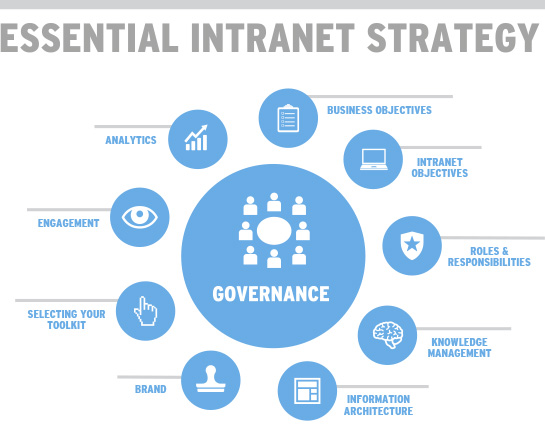It is easy to publish to a SharePoint intranet, and fast; in fact, too easy and fast, without proper intranet governance. Virtually anyone within an organization can create an intranet site, and publish pages, with little to no training, in seconds. This type of power and publishing comes at a cost, and intranet governance helps limit the damage of intranet sprawl.
Intranet governance details the ownership model (who owns and manages it), and the rules for creating pages and content (roles and responsibilities, and policies); SharePoint intranet governance is really no different than the standard intranet governance model, though it does require some special attention with respect to site creation.
SharePoint is replete with functionality and applications, and is the most comprehensive intranet / employee experience platform ever developed. It is, unfortunately, expensive, and and can be frustrating for content managers, and web content management scenarios. SharePoint isn’t a niche product that is supposed to be superb at web content management, or social networking; it’s a broad solution, one that has something for everybody; a solution that can please some, but not all.
SharePoint (SharePoint Online; SharePoint 2019) is appreciated for its simplicity, ease of deployment and publishing, and use out-of-the-box (OOB), though derided for problems (and the expense) customizing the employee experience (design, navigation and information architecture). However, SharePoint is 20-years in the making, but still falls short of best-of-breed web content management solutions (think Adobe and Sitecore). Ultimately, effective intranet content management — effective intranet governance — depends on people and process (and the rules that support both).

From a governance perspective, the governance criticism of SharePoint is not entirely fair. For all its strengths and weaknesses, SharePoint is fairly strong for governance when compared to other platforms. It is not perfect, but no solution is, and governance is largely independent of technology — it’s all about people and process. In other words, the intranet owner determines the governance, you set the rules, roles and accountabilities. Hence the necessity for an an end owner, the owner of the intranet or employee experience; someone must make the rules and enforce them.
Like the content of your website or intranet, planning and governance is technology agnostic; whether it’s SharePoint or another intranet technology platform, the necessity for and the approach to governance is the same. In short, governance lives and dies with its people, specifically the owner (and the rules they put in place, regardless of the technology).

While governance is highly specific and custom to the individual organization, and its culture and people — regardless of the technology — there are some issues specifically related to SharePoint that are worth noting, particularly around the deployment of team or collaboration sites, or Teams. Any person creating or deploying such a site should sign-off on a set of rules, and should be forced to renew or delete collaboration sites every six or twelve months.
In general though, the three most important governance requirements every intranet should have:
- Detailed ownership structure with names attached to each role, including executive champions
- Every page should have an owner, with the owner’s name and email automatically applied to each page
- Every page requires a very strong header that most accurately describes the content, and an expiry date
When building a governance model for SharePoint, the major components should include:
- The umbrella ownership model – Centralized? Decentralized? Collaborative?
- Defined ownership structure (names and titles)
- Roles and responsibilities (jobs and duties)
- Decision making process (who is responsible for what and when)
- Authorization (who is responsible for what and when)
- Policy (what is allowed, and what is not allowed)
- Expiration controls (content must be reviewed, renewed or deleted)
These issues and others are discussed in-depth including, SharePoint governance, and some of the specific, requisite steps and policies for implementing intranet and in the SharePoint Governance white paper.
Many world-class intranets and digital workplaces, including those from Coca-Cola, McDonald’s, Bayer, Microsoft, and others, with detailed case studies presented at this year’s Digital Workplace & Intranet Global Forum conference. Watch the full conference online, or select specific days, by visiting the Digital Workplace & Intranet Global Forum conference.
Want more intranet articles and case studies? SUBSCRIBE TO THE FREE INTRANET INSIGHT NEWSLETTER
